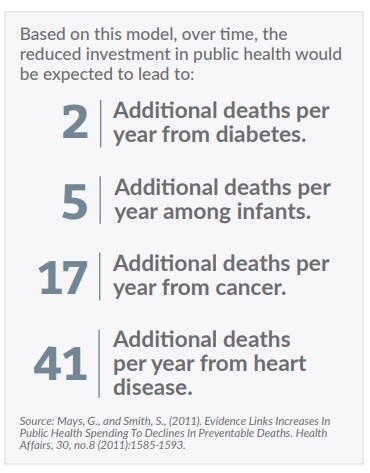Public Health Funding and Preventable Deaths
Given the recent attention on the proposed reduction in public health spending in Sedgwick County (KS), this topic has gained relevance and urgency. Fortunately, there is a study that was published in a highly respected, peer-reviewed journal in 2011 that explored this issue (Mays, G., 2011).
The study analyzed information from more than 2,000 communities in the United States to determine the relationship between funding levels for public health services and deaths from some preventable causes. The basic goal was to understand whether more spending on public health could prevent deaths from the kinds of things that you would expect public health services to prevent.
In short, the research showed that increased spending by local public health agencies over the thirteen-year period studied was linked to statistically significant declines in deaths from some preventable causes such as infant mortality, heart disease, diabetes and cancer. Increased local public health spending was also associated with declines in influenza deaths and deaths from all causes, but these findings were not statistically significant. Increased spending was not associated with a change in deaths from Alzheimer’s disease and other causes not likely to be affected by public health interventions.
Applying the Model in Sedgwick County
This analysis explores the potential impact of proposed reductions in public health spending in Sedgwick County using the model in the Mays study. Budget figures were obtained from the Sedgwick County Health Department covering the period 2013-2015.
To reduce the effect of year-to-year variations, the 2016 proposed budget was compared to the average of the budgets for the previous three years.
Mortality and population numbers were obtained from the state vital statistics system. The most recent mortality data are from 2011, 2012 and 2013. Population data is also available for 2014. To reduce the effect of year-to-year variations, a three-year mortality average was calculated for the period 2011-2013.
Applying the model from the Mays study, the proposed reductions in Sedgwick County public health spending were used to estimate the expected change in deaths from certain preventable causes.


